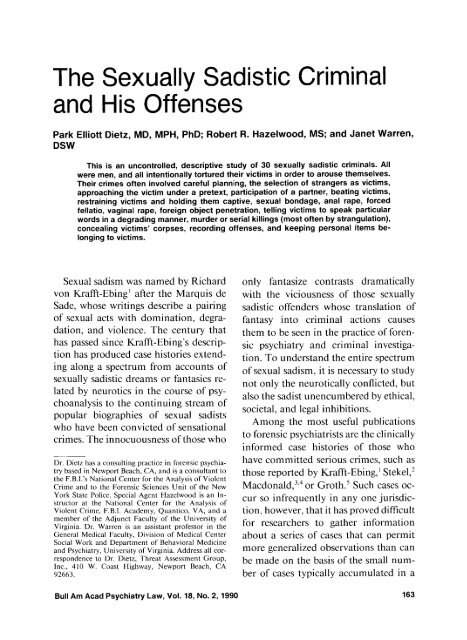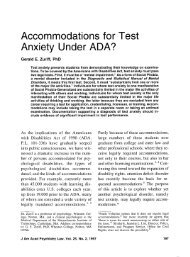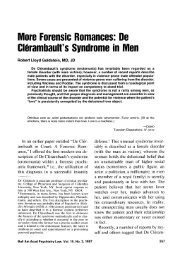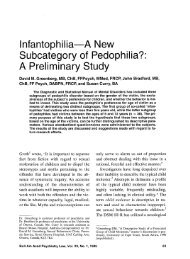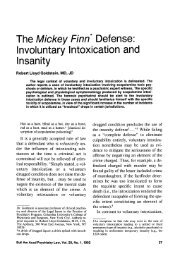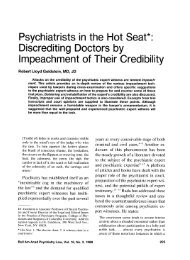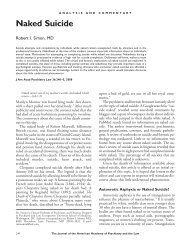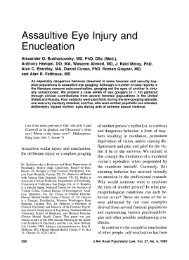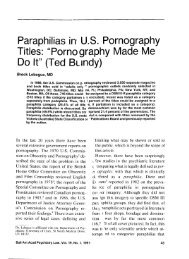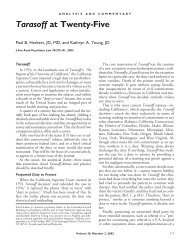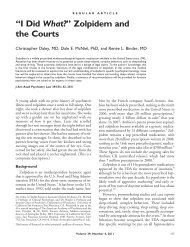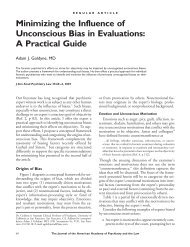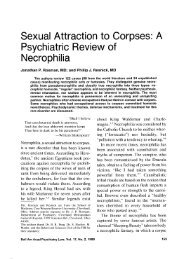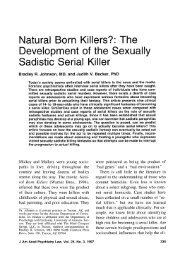The Sexually Sadistic Criminal and His Offenses - Journal of the ...
The Sexually Sadistic Criminal and His Offenses - Journal of the ...
The Sexually Sadistic Criminal and His Offenses - Journal of the ...
You also want an ePaper? Increase the reach of your titles
YUMPU automatically turns print PDFs into web optimized ePapers that Google loves.
<strong>The</strong> <strong>Sexually</strong> <strong>Sadistic</strong> <strong>Criminal</strong><br />
<strong>and</strong> <strong>His</strong> <strong>Offenses</strong><br />
Park Elliott Dietz, MD, MPH, PhD; Robert R. Hazelwood, MS; <strong>and</strong> Janet Warren,<br />
DSW<br />
This is an uncontrolled, descriptive study <strong>of</strong> 30 sexually sadistic criminals. All<br />
were men, <strong>and</strong> all intentionally tortured <strong>the</strong>ir victims in order to arouse <strong>the</strong>mselves.<br />
<strong>The</strong>ir crimes <strong>of</strong>ten involved careful planning, <strong>the</strong> selection <strong>of</strong> strangers as victims,<br />
approaching <strong>the</strong> victim under a pretext, participation <strong>of</strong> a partner, beating victims,<br />
restraining victims <strong>and</strong> holding <strong>the</strong>m captive, sexual bondage, anal rape, forced<br />
fellatio, vaginal rape, foreign object penetration, telling victims to speak particular<br />
words in a degrading manner, murder or serial killings (most <strong>of</strong>ten by strangulation),<br />
concealing victims' corpses, recording <strong>of</strong>fenses, <strong>and</strong> keeping personal items be-<br />
longing to victims.<br />
Sexual sadism was named by Richard<br />
von Krafft-Ebing' after <strong>the</strong> Marquis de<br />
Sade, whose writings describe a pairing<br />
<strong>of</strong> sexual acts with domination, degra-<br />
dation, <strong>and</strong> violence. <strong>The</strong> century that<br />
has passed since Krafft-Ebing's descrip-<br />
tion has produced case histories extend-<br />
ing along a spectrum from accounts <strong>of</strong><br />
sexually sadistic dreams or fantasies re-<br />
lated by neurotics in <strong>the</strong> course <strong>of</strong> psy-<br />
choanalysis to <strong>the</strong> continuing stream <strong>of</strong><br />
popular biographies <strong>of</strong> sexual sadists<br />
who have been convicted <strong>of</strong> sensational<br />
crimes. <strong>The</strong> innocuousness <strong>of</strong> those who<br />
Dr. Dietz has a consulting practice in forensic psychia-<br />
try based in Newport Beach, CA, <strong>and</strong> is a consultant to<br />
<strong>the</strong> F.B.I.'s National Center for <strong>the</strong> Analysis <strong>of</strong> Violent<br />
Crime <strong>and</strong> to <strong>the</strong> Forensic Sciences Unit <strong>of</strong> <strong>the</strong> New<br />
York State Police. Special Agent Hazelwood is an In-<br />
structor at <strong>the</strong> National Center for <strong>the</strong> Analysis <strong>of</strong><br />
Violent Crime, F.B.I. Academy, Quantico, VA, <strong>and</strong> a<br />
member <strong>of</strong> <strong>the</strong> Adjunct Faculty <strong>of</strong> <strong>the</strong> University <strong>of</strong><br />
Virginia. Dr. Warren is an assistant pr<strong>of</strong>essor in <strong>the</strong><br />
General Medical Faculty, Division <strong>of</strong> Medical Center<br />
Social Work <strong>and</strong> Department <strong>of</strong> Behavioral Medicine<br />
<strong>and</strong> Psychiatry, University <strong>of</strong> Virginia. Address all cor-<br />
respondence to Dr. Dietz, Threat Assessment Group,<br />
Inc., 410 W. Coast Highway, Newport Beach, CA<br />
92663.<br />
Bull Am Acad Psychiatry Law, Vol. 18, No. 2, 1990<br />
only fantasize contrasts dramatically<br />
with <strong>the</strong> viciousness <strong>of</strong> those sexually<br />
sadistic <strong>of</strong>fenders whose translation <strong>of</strong><br />
fantasy into criminal actions causes<br />
<strong>the</strong>m to be seen in <strong>the</strong> practice <strong>of</strong> forensic<br />
psychiatry <strong>and</strong> criminal investigation.<br />
To underst<strong>and</strong> <strong>the</strong> entire spectrum<br />
<strong>of</strong> sexual sadism, it is necessary to study<br />
not only <strong>the</strong> neurotically conflicted, but<br />
also <strong>the</strong> sadist unencumbered by ethical,<br />
societal, <strong>and</strong> legal inhibitions.<br />
Among <strong>the</strong> most useful publications<br />
to forensic psychiatrists are <strong>the</strong> clinically<br />
informed case histories <strong>of</strong> those who<br />
have committed serious crimes, such as<br />
those reported by Krafft-Ebing,' Stekel,2<br />
Macd~nald,~?~ or Groth.' Such cases occur<br />
so infrequently in any one jurisdiction,<br />
however, that it has proved difficult<br />
for researchers to ga<strong>the</strong>r information<br />
about a series <strong>of</strong> cases that can permit<br />
more generalized observations than can<br />
be made on <strong>the</strong> basis <strong>of</strong> <strong>the</strong> small number<br />
<strong>of</strong> cases typically accumulated in a<br />
163
single individual's practice. For this ar-<br />
ticle we used <strong>the</strong> unique resources <strong>of</strong> <strong>the</strong><br />
National Center for <strong>the</strong> Analysis <strong>of</strong> Vi-<br />
olent Crime to study a series <strong>of</strong> sexual<br />
sadists who have engaged in remarkably<br />
predatory behavior.<br />
Although <strong>the</strong> men in this series were<br />
serious criminals, it is important to rec-<br />
ognize that sexual sadists, like o<strong>the</strong>r par-<br />
aphiles, do not necessarily engage in any<br />
actions in fulfillment <strong>of</strong> <strong>the</strong> ~araphilia.~<br />
Indeed, it is possible that a majority <strong>of</strong><br />
sexual sadists never engage in a sexually<br />
sadistic act, much less a crime. Among<br />
those who act on <strong>the</strong>ir fantasies, <strong>the</strong>re<br />
are those who limit <strong>the</strong>ir actions to law-<br />
ful behaviors with consenting partners<br />
or to behaviors with paid partners. In<br />
some cases, however, <strong>the</strong> sexual sadist<br />
does not content himself with lawful or<br />
quasi-lawful adaptations, but ra<strong>the</strong>r in-<br />
dulges himself at <strong>the</strong> expense <strong>of</strong> unwill-<br />
ing partners.' It is this latter group <strong>of</strong><br />
sexually sadistic <strong>of</strong>fenders that poses <strong>the</strong><br />
greatest problem for society.<br />
Sexual sadism has <strong>of</strong>ten been con-<br />
founded with o<strong>the</strong>r mental disorders,<br />
particularly where a psychotic <strong>of</strong>fender<br />
has cruelly harmed someone or where a<br />
patient has described bizarre fantasies.<br />
In our experience <strong>the</strong> extremities <strong>of</strong> be-<br />
havior among sexually sadistic <strong>of</strong>fenders<br />
prove perplexing to even seasoned cli-<br />
nicians, who find <strong>the</strong>mselves tempted to<br />
ascribe psychosis to those who engage in<br />
extraordinarily cruel acts despite <strong>the</strong> ab-<br />
sence <strong>of</strong> delusions, hallucinations, or<br />
markedly illogical thinking. Compound-<br />
ing <strong>the</strong> diagnostician's difficulty, <strong>the</strong> <strong>of</strong>-<br />
fenders generally conceal <strong>the</strong> truth-<br />
sometimes even in <strong>the</strong> face <strong>of</strong> compel-<br />
Dietz et a/.<br />
ling evidence <strong>of</strong> guilt-<strong>and</strong> even when<br />
<strong>the</strong>y reveal it, it is so bizarre as to invite<br />
disbelief.<br />
This report focuses on 30 sexually sa-<br />
distic criminals who probably have char-<br />
acter pathology in addition to <strong>the</strong> Axis I<br />
condition <strong>of</strong> sexual sadism, but this does<br />
not mean that sexual sadism is invaria-<br />
bly associated with such pathology. Pre-<br />
sumably, sexual sadism can occur in <strong>the</strong><br />
absence <strong>of</strong> any o<strong>the</strong>r diagnosable mental<br />
disorder or in combination with any<br />
o<strong>the</strong>r diagnosis. Even here, however, diagnostic<br />
errors are common. <strong>The</strong> behavior<br />
<strong>of</strong> a sexual sadist with antisocial personality<br />
disorder may be markedly different<br />
from one with schizoid<br />
personality disorder, for <strong>the</strong> latter may<br />
be so shy as to have limited <strong>the</strong> number<br />
<strong>of</strong> victims attacked <strong>and</strong> so odd when<br />
examined as to invite a psychotic diagnosis.<br />
Likewise, <strong>the</strong> clinician may find it<br />
difficult to differentiate <strong>the</strong> individual<br />
who engages in sexual behavior <strong>of</strong> a<br />
seemingly sadistic nature only when psychotic<br />
from <strong>the</strong> individual with an established<br />
pattern <strong>of</strong> sexual sadism who subsequently<br />
becomes psychotic. Only <strong>the</strong><br />
latter is a sexual sadist, as all manner <strong>of</strong><br />
sexual thoughts <strong>and</strong> behaviors can occur<br />
during psychosis without a diagnosis <strong>of</strong><br />
a paraphilia being warranted.<br />
A variety <strong>of</strong> cruel sexual <strong>and</strong> criminal<br />
acts has evoked attributions <strong>of</strong> sexual<br />
sadism, even by so astute an observer as<br />
Stekel.* Rada8 has surveyed <strong>the</strong> varied,<br />
<strong>of</strong>ten contradictory, definitions <strong>of</strong> sadism<br />
that have been <strong>of</strong>fered by psychiatrists<br />
<strong>of</strong> various camps. To be clear, we<br />
must state our position. which is that<br />
only those crimes reflective <strong>of</strong> an endur-<br />
164 Bull Am Acad Psychiatry Law, Vol. 18, No. 2, 1990
<strong>The</strong> <strong>Sexually</strong> <strong>Sadistic</strong> <strong>Criminal</strong><br />
ing pattern <strong>of</strong> sexual arousal in response<br />
to sadistic imagery ought to be regarded<br />
as sexually sadistic <strong>of</strong>fenses.<br />
Although such varied actions as mu-<br />
tilation followed by murder, murder fol-<br />
lowed by mutilation, <strong>and</strong> cannibalism<br />
have been said to provide sexual excite-<br />
ment to sadistic murderer^,^ <strong>the</strong>se ac-<br />
tions are not necessarily indicative <strong>of</strong><br />
ei<strong>the</strong>r sexual excitement or sexual sad-<br />
ism. <strong>Sexually</strong> sadistic <strong>of</strong>fenses must be<br />
differentiated from seemingly similar<br />
crimes, such as genital mutilation moti-<br />
vated by o<strong>the</strong>r than sadistic sexual<br />
arousal patterns9 (e.g., <strong>the</strong> severely dis-<br />
turbed prostitute who emasculates her<br />
client while he sleeps or <strong>the</strong> schizo-<br />
phrenic murderer who dissects his vic-<br />
tim from pelvis to neck); cruelty moti-<br />
vated by revenge or o<strong>the</strong>r nonsexual mo-<br />
tives (e.g., <strong>the</strong> gang which tortures <strong>and</strong><br />
castrates a man in retaliation for his<br />
liaison with a gang member's "girl");<br />
pathological group behavior (e.g., atroc-<br />
ities against civilians in a combat zone);<br />
torture during interrogation; ritualized<br />
human sacrifice (e.g., within <strong>the</strong> Aztec<br />
culture); or institutionally sanctioned<br />
cruelty (e.g., concentration camp atroc-<br />
ities). Likewise, acts such as those that<br />
occur in sexually sadistic role-playing<br />
(e.g., by prostitutes or o<strong>the</strong>rs who enact<br />
a sadistic role for <strong>the</strong> benefit <strong>of</strong> <strong>the</strong>ir<br />
clients, partners, or pornographers) <strong>and</strong><br />
sexually sadistic acts among psychotics<br />
or sexual experimenters must be care-<br />
fully distinguished from acts indicating<br />
sexual sadism.<br />
Although not universally true, some<br />
sexual sadists have considerable insight<br />
into <strong>the</strong>ir sexual deviation <strong>and</strong> devote<br />
significant energy to self-scrutiny. One<br />
<strong>of</strong> <strong>the</strong> clearest definitions <strong>of</strong> sexual sad-<br />
ism comes from <strong>the</strong> writings <strong>of</strong> a man<br />
who kidnapped, kept captive, raped, so-<br />
domized, <strong>and</strong> in some instances mur-<br />
dered victims in several states over an<br />
extended period <strong>of</strong> time. Audio tapes <strong>of</strong><br />
his sexual torture <strong>of</strong> his fourth wife <strong>and</strong><br />
<strong>of</strong> one <strong>of</strong> his stranger victims, photo-<br />
graphs he took <strong>of</strong> foreign object penetra-<br />
tion <strong>of</strong> ano<strong>the</strong>r captive victim 20 years<br />
earlier, <strong>and</strong> his own written plans for<br />
building an "S & M play area," cells,<br />
<strong>and</strong> an incinerator, confirm an enduring<br />
pattern <strong>of</strong> sexual arousal to <strong>the</strong> suffering<br />
<strong>of</strong> his sexual partners. He wrote:<br />
Sadism: <strong>The</strong> wish to inflict pain on o<strong>the</strong>rs is<br />
not <strong>the</strong> essence <strong>of</strong> sadism. One essential im-<br />
pulse: to have complete mastery over ano<strong>the</strong>r<br />
person, to make him/her a helpless object <strong>of</strong><br />
our will, to become <strong>the</strong> absolute ruler over her.<br />
to become her God, to do with her as one<br />
pleases. To humiliate her. to enslave her. are<br />
means to this end. <strong>and</strong> <strong>the</strong> most important<br />
radical aim is to make her suffer since <strong>the</strong>re is<br />
no greater power over ano<strong>the</strong>r person than that<br />
<strong>of</strong> inflictingpain on her to force her to undergo<br />
suffering without her being able to defend her-<br />
self. <strong>The</strong> pleasure in <strong>the</strong> complete domination<br />
over ano<strong>the</strong>r person is <strong>the</strong> very essence <strong>of</strong> <strong>the</strong><br />
<strong>Sadistic</strong> drive. [Emphasis in original.]<br />
Although it is possible that he may<br />
have copied this material from a pub-<br />
lished source, a diligent search has failed<br />
to disclose a similar passage in any <strong>of</strong><br />
<strong>the</strong> writings on sexual sadism. <strong>The</strong> pas-<br />
sage is consistent with both <strong>the</strong> o<strong>the</strong>r<br />
writings <strong>of</strong> this man <strong>and</strong> his enduring<br />
pattern <strong>of</strong> behavior. More importantly,<br />
it is consistent with <strong>the</strong> behavior <strong>of</strong> all<br />
<strong>of</strong> <strong>the</strong> sexually sadistic <strong>of</strong>fenders we have<br />
studied.<br />
Bull Am Acad Psychiatry Law, Vol. 18, No. 2, 1990 165
Methods<br />
Case files were drawn from a pool <strong>of</strong><br />
cases referred to or studied by <strong>the</strong> Na-<br />
tional Center for <strong>the</strong> Analysis <strong>of</strong> Violent<br />
Crime (NCAVC). When President Ron-<br />
ald Reagan announced <strong>the</strong> establish-<br />
ment <strong>of</strong> <strong>the</strong> NCAVC in 1984, he iden-<br />
tified its primary mission as that <strong>of</strong> iden-<br />
tifying <strong>and</strong> tracking repeat killers. l o <strong>The</strong><br />
NCAVC today encompasses four pro-<br />
grams: <strong>the</strong> Pr<strong>of</strong>iling <strong>and</strong> Consultation<br />
Program (now <strong>the</strong> <strong>Criminal</strong> Investiga-<br />
tive Analysis Program), <strong>the</strong> Violent<br />
<strong>Criminal</strong> Apprehension Program, <strong>the</strong><br />
Research <strong>and</strong> Development Program,<br />
<strong>and</strong> <strong>the</strong> Training Program. ' ' <strong>The</strong><br />
NCAVC is a tertiary referral center for<br />
unsolved crimes <strong>and</strong> particular types <strong>of</strong><br />
extreme <strong>of</strong>fenses, providing services to<br />
law enforcement agencies <strong>and</strong> prosecu-<br />
tors analogous to <strong>the</strong> services provided<br />
by <strong>the</strong> Centers for Disease Control to<br />
state <strong>and</strong> local health departments12such<br />
as epidemiologic surveillance, intelli-<br />
gence, specialized consultation, training,<br />
<strong>and</strong> research.<br />
<strong>The</strong> sampling universe for <strong>the</strong> present<br />
study consisted <strong>of</strong> all cases identified as<br />
possible sexually sadistic criminals that<br />
were submitted to <strong>the</strong> NCAVC for<br />
analysis or were sent to specialists within<br />
<strong>the</strong> NCAVC for teaching <strong>and</strong> research<br />
purposes between 1984 <strong>and</strong> 1989. Each<br />
case within this universe was screened<br />
by <strong>the</strong> authors for <strong>the</strong> presence <strong>of</strong> an<br />
enduring pattern <strong>of</strong> sexual arousal in<br />
response to images <strong>of</strong> suffering or hu-<br />
miliation. For a case to be admitted to<br />
<strong>the</strong> study, all three authors had to agree<br />
that a factual basis was available for<br />
finding that <strong>the</strong> subject had been sex-<br />
Dietz et a/.<br />
ually aroused in response to images <strong>of</strong><br />
suffering or humiliation on two or more<br />
occasions spanning an interval <strong>of</strong> at least<br />
six months. Most <strong>of</strong>ten <strong>the</strong> evidence <strong>of</strong><br />
sexual arousal consisted <strong>of</strong> documented<br />
sexual acts or self-reported sexual<br />
arousal occurring simultaneously with a<br />
victim's expressed suffering. Most <strong>of</strong> <strong>the</strong><br />
cases that o<strong>the</strong>rs had believed to be pos-<br />
sible sexual sadists but that were elimi-<br />
nated through this screening process<br />
were those in which an <strong>of</strong>fender com-<br />
mitted a single rape or murder with tor-<br />
ture or mutilation, but without evidence<br />
<strong>of</strong> an enduring pattern <strong>of</strong> arousal to such<br />
activities, or cases in which cruel behav-<br />
iors occurred at times o<strong>the</strong>r than those<br />
at which <strong>the</strong> victim was conscious <strong>and</strong><br />
<strong>the</strong> <strong>of</strong>fender aroused. Thus, for example,<br />
we excluded cases in which a rapist in-<br />
jured or killed his victim if <strong>the</strong>re was no<br />
evidence <strong>of</strong> sexual arousal accompany-<br />
ing <strong>the</strong> injury or killing <strong>and</strong> cases in<br />
which sexual activity or mutilation oc-<br />
curred only after a victim was uncon-<br />
scious or dead. <strong>The</strong> sample thus consists<br />
<strong>of</strong> consecutively referred sexually sadis-<br />
tic <strong>of</strong>fenders, but two <strong>of</strong> <strong>the</strong> <strong>of</strong>fenders<br />
admitted to <strong>the</strong> study had committed<br />
<strong>the</strong>ir crimes many years before <strong>the</strong> case<br />
files were referred for teaching <strong>and</strong> re-<br />
search purposes.<br />
For each case, information was avail-<br />
able from at least two <strong>of</strong> <strong>the</strong> following<br />
sources: police investigative reports,<br />
crime scene photographs. victim state-<br />
ments, reports <strong>of</strong> interviews with family<br />
members, confessions, psychiatric re-<br />
ports, gr<strong>and</strong> jury or trial transcripts,<br />
presentencing reports, <strong>and</strong> prison rec-<br />
ords. In addition to <strong>the</strong>se, materials pro-<br />
166 Bull Am Acad Psychiatry Law, Vol. 18, No. 2, 1990
<strong>The</strong> <strong>Sexually</strong> <strong>Sadistic</strong> <strong>Criminal</strong><br />
duced by <strong>the</strong> <strong>of</strong>fenders such as manu-<br />
scripts, diaries, photographs, sketches,<br />
audio tapes, videotapes. <strong>and</strong> threatening<br />
letters were available in <strong>the</strong> majority <strong>of</strong><br />
cases. Five <strong>of</strong> <strong>the</strong> 30 subjects have been<br />
interviewed at great length by at least<br />
one <strong>of</strong> <strong>the</strong> authors, with informed con-<br />
sent. In six <strong>of</strong> <strong>the</strong> 30 cases, published<br />
book-length biographies were used to<br />
supplement available investigative infor-<br />
mation. <strong>The</strong> many published biogra-<br />
phies <strong>of</strong> serial killers include some no-<br />
toriously unreliable <strong>and</strong> inaccurate vol-<br />
umes (including some with fabricated<br />
data), but <strong>the</strong> ones used here are among<br />
<strong>the</strong> most reliable <strong>of</strong> such books accord-<br />
ing to investigators familiar with <strong>the</strong><br />
cases. For two <strong>of</strong> <strong>the</strong> cases <strong>the</strong> book<br />
proved <strong>the</strong> more complete source <strong>of</strong><br />
data, but in <strong>the</strong> o<strong>the</strong>r four <strong>the</strong> investi-<br />
gative information was superior to <strong>the</strong><br />
book-length account.<br />
Each <strong>of</strong> <strong>the</strong> 30 men on whom this<br />
report is based meets stringent criteria<br />
for sexual sadism, having engaged in<br />
repeated fantasies <strong>and</strong> actions evidenc-<br />
ing sexual arousal to <strong>the</strong> suffering <strong>and</strong><br />
humiliation <strong>of</strong> o<strong>the</strong>r persons for periods<br />
in excess <strong>of</strong> six months. Each <strong>of</strong> <strong>the</strong> 30<br />
also engaged in extensive patterns <strong>of</strong><br />
antisocial behavior in adulthood. <strong>The</strong><br />
available evidence does not <strong>of</strong>ten in-<br />
clude juvenile police records (which<br />
were generally sealed) or extensive infor-<br />
mation on <strong>the</strong> adolescence <strong>of</strong> <strong>the</strong> men.<br />
It is thus not possible to be certain how<br />
many <strong>of</strong> <strong>the</strong> men would meet DSM-III-<br />
RI3 criteria for antisocial personality dis-<br />
order. None <strong>of</strong> <strong>the</strong> individuals studied<br />
was psychotic at <strong>the</strong> time <strong>of</strong> onset <strong>of</strong> a<br />
Bull Am Acad Psychiatry Law, Vol. 18, NO. 2, 1990<br />
pattern <strong>of</strong> sexually sadistic behavior, but<br />
one became psychotic later in life.<br />
A11 <strong>of</strong> <strong>the</strong> data reported in this article<br />
must be regarded as minimum estimates<br />
<strong>of</strong> <strong>the</strong> true frequency <strong>of</strong> <strong>the</strong> variables<br />
studied among this population because<br />
<strong>of</strong> variations in <strong>the</strong> quantity <strong>of</strong> infor-<br />
mation available about particular cases.<br />
<strong>The</strong> data about which we are least con-<br />
fident are those on reported physical <strong>and</strong><br />
sexual abuse during childhood, because<br />
no systematic effort was made to collect<br />
such data or to verify spontaneous<br />
claims <strong>of</strong> abuse.<br />
Results<br />
Offender Characteristics Table I<br />
presents <strong>the</strong> characteristics <strong>of</strong> <strong>of</strong>fenders<br />
in <strong>the</strong> sample. Note that each <strong>of</strong> <strong>the</strong>se<br />
characteristics is also found among per-<br />
sons who are nei<strong>the</strong>r sexual sadists nor<br />
<strong>of</strong>fenders. Without comparable data on<br />
males in <strong>the</strong> general population or o<strong>the</strong>r<br />
comparison groups, <strong>the</strong>se data must be<br />
interpreted cautiously. Each <strong>of</strong> <strong>the</strong> <strong>of</strong>-<br />
fenders was male, <strong>and</strong> all but one was<br />
white. Forty-seven percent <strong>of</strong> <strong>the</strong> men<br />
came from homes characterized by pa-<br />
rental infidelity or divorce; approxi-<br />
mately equal proportions reportedly had<br />
been physically abused (23%) or sexually<br />
abused (20%) in childhood. While com-<br />
mitting <strong>of</strong>fenses, 43 percent were mar-<br />
ried. <strong>The</strong> nine who were incestuously<br />
involved with <strong>the</strong>ir children comprised<br />
30 percent <strong>of</strong> <strong>the</strong> total sample, but 60<br />
percent <strong>of</strong> <strong>the</strong> 15 subjects who had chil-<br />
dren.<br />
Forty-three percent were known to<br />
have had homosexual experiences, ex-<br />
cluding childhood sex play <strong>and</strong> two cases<br />
167
Table 1<br />
Characteristics <strong>of</strong> <strong>Sexually</strong> <strong>Sadistic</strong> <strong>Criminal</strong>s<br />
Characteristics<br />
Male<br />
White<br />
Parental infidelity or divorce<br />
Physically abused in childhood<br />
<strong>Sexually</strong> abused in childhood<br />
Married at time <strong>of</strong> <strong>of</strong>fense<br />
Incestuous involvement with own child<br />
Known homosexual experience*<br />
Known cross-dressing<br />
Known history <strong>of</strong> peeping, obscene telephone calls, or inde-<br />
cent exposure<br />
Shared sexual partners with o<strong>the</strong>r men<br />
Education beyond high school<br />
Military experience<br />
Established reputation as solid citizen<br />
Drug abuse (o<strong>the</strong>r than alcohol)<br />
Suicide attempt<br />
Excessive driving<br />
Police "buff (excessive interest in police activities <strong>and</strong> para-<br />
phernalia)<br />
' Excluding childhood sex play.<br />
in which suspected homosexual activity<br />
could not be confirmed. Nonsadistic<br />
paraphilic activities included cross-<br />
dressing (20%) <strong>and</strong> minor sex <strong>of</strong>fenses<br />
(peeping, obscene telephone calls, or in-<br />
decent exposure; 20%). Six men shared<br />
<strong>the</strong>ir consenting sexual partners with<br />
o<strong>the</strong>r men (including three who shared<br />
<strong>the</strong>ir wives).<br />
Forty-three percent had been edu-<br />
cated beyond <strong>the</strong> high school level. Of<br />
<strong>the</strong> 10 known to have military experi-<br />
ence, eight served in <strong>the</strong> ground forces.<br />
At least five had been honorably dis-<br />
charged, <strong>and</strong> one received a medical dis-<br />
charge for unknown reasons. <strong>The</strong> occu-<br />
pations <strong>of</strong> <strong>the</strong>se subjects were baker<br />
(two), cook, chef, c<strong>and</strong>y maker, barten-<br />
der, restaurant owner, musician, boun-<br />
cer/truck driver, laborer, rancher, log-<br />
ger, television repairman, barberlnude<br />
Dietz et al.<br />
photo studio proprietor, amusement<br />
park train conductor, mechanic, con-<br />
struction worker, construction contrac-<br />
tor, house painter, upholsterer, sales-<br />
man, sales manager, real estate devel-<br />
operlrace car driver, photographer,<br />
cardiovascular technician, security<br />
guard, sheriffs deputy, law student, mil-<br />
itary <strong>of</strong>ficer, <strong>and</strong> banker. Note that <strong>the</strong><br />
majority <strong>of</strong> <strong>the</strong>se occupations involve<br />
contact with <strong>the</strong> public. Thirty percent<br />
<strong>of</strong> <strong>the</strong> <strong>of</strong>fenders had established reputa-<br />
tions as solid citizens through involve-<br />
ment in civic activities, volunteer work,<br />
charitable contributions, political activ-<br />
ity, <strong>and</strong> sound business dealings.<br />
Half <strong>of</strong> <strong>the</strong> <strong>of</strong>fenders were known to<br />
abuse drugs o<strong>the</strong>r than alcohol. Thirteen<br />
percent had a history <strong>of</strong> at least one<br />
suicide attempt. <strong>The</strong>se four men had a<br />
total <strong>of</strong> six parasuicidal episodes, includ-<br />
168 Bull Am Acad Psychiatry Law, Vol. 18, No. 2, 1990
<strong>The</strong> <strong>Sexually</strong> <strong>Sadistic</strong> <strong>Criminal</strong><br />
ing hanging (two), carbon monoxide<br />
poisoning, industrial chemical ingestion,<br />
wrist cutting, <strong>and</strong> drug overdose.<br />
Excessive driving, defined as driving<br />
with no clear goal or driving long dis-<br />
tances only to spontaneously change<br />
course in ano<strong>the</strong>r direction, character-<br />
ized 40 percent <strong>of</strong> <strong>the</strong> men. Thirty per-<br />
cent <strong>of</strong> <strong>the</strong> men were police "buffs" who<br />
habitually showed excessive interest in<br />
police activities <strong>and</strong> paraphernalia. This<br />
interest ranged from collecting literature<br />
dealing with police technology to having<br />
complete police uniforms, counterfeit<br />
identification <strong>and</strong> badges, <strong>and</strong> vehicles<br />
modified to resemble police cars (black<br />
wall tires, two-way radio, Bearcat scan-<br />
ner, whip antenna, flashing red lights,<br />
<strong>and</strong> siren).<br />
Seventeen (57%) <strong>of</strong> <strong>the</strong> men had no<br />
known arrest history prior to <strong>the</strong>ir arrest<br />
for <strong>the</strong> sadistic <strong>of</strong>fenses described below.<br />
Thirteen (43%) had prior arrests for a<br />
variety <strong>of</strong> nonsexual <strong>and</strong> nonsadistic<br />
sexual <strong>of</strong>fenses.<br />
Eighty-three percent <strong>of</strong> <strong>the</strong> men main-<br />
tained collections <strong>of</strong> items related to sex-<br />
ual or violent <strong>the</strong>mes or both. <strong>The</strong> most<br />
commonly occumng collection was por-<br />
nography (53%), followed in frequency<br />
by guns (37%), bondage paraphernalia<br />
(27%). <strong>and</strong> detective magazines (23%).14<br />
Smaller proportions <strong>of</strong> men collected<br />
knives (lo%), Soldier <strong>of</strong> Fortune maga-<br />
zine (7%), sexual devices (7%), <strong>and</strong><br />
women's undergarments (3%). As with<br />
<strong>the</strong> <strong>of</strong>fender characteristics given in Ta-<br />
ble 1, <strong>the</strong> collections specified here are<br />
not necessarily associated with ei<strong>the</strong>r<br />
sexual sadism or criminality.<br />
Offense Characteristics Characteris-<br />
tics <strong>of</strong> <strong>the</strong> <strong>of</strong>fenses are given in Table 2.<br />
Eleven (37%) <strong>of</strong> <strong>the</strong> men committed at<br />
least some <strong>of</strong> <strong>the</strong>ir <strong>of</strong>fenses with a part-<br />
ner who assisted in all phases <strong>of</strong> <strong>the</strong><br />
crime. <strong>The</strong>se 11 <strong>of</strong>fenders were assisted<br />
by 11 male partners <strong>and</strong> seven female<br />
partners. Two <strong>of</strong> <strong>the</strong> male partners were<br />
<strong>the</strong> <strong>of</strong>fender's fa<strong>the</strong>rs. Five <strong>of</strong> <strong>the</strong> female<br />
partners were wives <strong>of</strong> <strong>the</strong> <strong>of</strong>fenders, <strong>and</strong><br />
one was a victim who had been held<br />
captive for weeks before she began as-<br />
sisting in <strong>the</strong> abduction <strong>and</strong> torture<br />
<strong>of</strong> o<strong>the</strong>r victims. Five <strong>of</strong> <strong>the</strong> <strong>of</strong>fenders<br />
shared sexual access to <strong>the</strong>ir victims with<br />
1 1 o<strong>the</strong>r men.<br />
Ninety-three percent <strong>of</strong> <strong>the</strong> <strong>of</strong>fenders<br />
were judged to have carefully planned<br />
<strong>the</strong>ir <strong>of</strong>fenses, as evidenced by such be-<br />
haviors as studying law enforcement<br />
procedures; studying <strong>and</strong> collecting<br />
weapons; constructing a torture rack or<br />
a specially equipped torture room; alter-<br />
ing' a vehicle for use in abduction <strong>and</strong><br />
torture (soundpro<strong>of</strong>ing a van, disabling<br />
windows <strong>and</strong> door h<strong>and</strong>les, or installing<br />
police vehicle accessories); preparing a<br />
"torture kit" containing binding mate-<br />
rials, torture implements, weapons,<br />
cameras, recording devices, <strong>and</strong> burial<br />
equipment (e.g., a shovel <strong>and</strong> lime); tak-<br />
ing provisions for travel to remote loca-<br />
tions (e.g., water <strong>and</strong> food for <strong>the</strong> desert;<br />
extra fuel to fly to a remote isl<strong>and</strong>);<br />
conducting systematic surveillance <strong>and</strong><br />
stalking <strong>of</strong> victims; impersonating a po-<br />
lice <strong>of</strong>ficer in <strong>the</strong> commission <strong>of</strong> <strong>the</strong><br />
<strong>of</strong>fense (23%) or o<strong>the</strong>r elaborate ruses;<br />
wearing gloves to avoid leaving finger-<br />
prints; <strong>and</strong> taking <strong>the</strong> victim to a loca-<br />
tion selected in advance (77%).<br />
Bull Am Acad Psychiatry Law, Vol. 18, No. 2, 1990 169
Table 2<br />
Characteristics <strong>of</strong> <strong>Offenses</strong><br />
Characteristics n O/O<br />
A partner assisted in <strong>of</strong>fense<br />
Careful planning <strong>of</strong> <strong>of</strong>fense<br />
Impersonation <strong>of</strong> police in commission <strong>of</strong> <strong>of</strong>fense<br />
Victim taken to preselected location<br />
Victim kept in captivity for 24 hours or more<br />
Victim bound, blindfolded, or gagged<br />
Sexual bondage <strong>of</strong> victim*<br />
Anal rape <strong>of</strong> victim<br />
Forced victim to perform fellatio<br />
Vaginal rape <strong>of</strong> victim<br />
Foreign object penetration <strong>of</strong> victim<br />
Variety <strong>of</strong> sexual acts with <strong>the</strong> victimt<br />
Sexual dysfunction during <strong>of</strong>fense<br />
Unemotional, detached affect during <strong>of</strong>fense<br />
Told victim what to say during assault<br />
Intentional torture<br />
Murdered victim<br />
Committed serial murders (three or more victims)<br />
Concealed victim's corpse<br />
Victim beaten (blunt force trauma)<br />
Recorded <strong>the</strong> <strong>of</strong>fense*<br />
Kept personal item belonging to victim<br />
Dietz et a/.<br />
- -- -<br />
' Sexual bondage is distinguished from bondage for <strong>the</strong> sole purpose <strong>of</strong> restraining <strong>the</strong> victim's movements by <strong>the</strong><br />
use <strong>of</strong> a variety <strong>of</strong> positions, excessive binding, symmetrical bindings, <strong>and</strong> neatness.<br />
t A variety <strong>of</strong> sexual acts is defined as having subjected <strong>the</strong> victim to at least three <strong>of</strong> <strong>the</strong> following: vaginal rape,<br />
forced fellatio, anal rape, foreign object penetration.<br />
$ Includes recordings through writings, drawings, photographs, audio tapes, or videotapes.<br />
<strong>The</strong> most commonly used means <strong>of</strong><br />
gaining access to <strong>the</strong> victim was deter-<br />
mined for each <strong>of</strong> <strong>the</strong> 30 <strong>of</strong>fenders. <strong>The</strong><br />
largest number (27 or 90.0%) used a<br />
"con" approach,15 openly approaching<br />
<strong>the</strong> victim under a pretext such as re-<br />
questing or <strong>of</strong>fering assistance, asking<br />
directions, or making an arrest. For ex-<br />
ample, one man hired models to pose in<br />
photo sessions, ostensibly to be used for<br />
<strong>the</strong> covers <strong>of</strong> detective magazines, but<br />
would take <strong>the</strong> victims to <strong>the</strong> desert,<br />
photograph, <strong>and</strong> strangle <strong>the</strong>m. Two<br />
men tended to use "surprise" ap-<br />
proaches, in which <strong>the</strong>y suddenly<br />
grabbed <strong>the</strong> victims to gain control. One<br />
used a "blitz" approach, suddenly strik-<br />
ing <strong>the</strong> victims over <strong>the</strong> head with a<br />
blunt object.<br />
Sixty percent <strong>of</strong> <strong>the</strong> <strong>of</strong>fenders kept one<br />
or more <strong>of</strong> <strong>the</strong>ir victims captive for pe-<br />
riods ranging from 24 hours to six weeks<br />
before killing or releasing <strong>the</strong>m. Three<br />
<strong>of</strong>fenders persuaded or coerced former<br />
captives to return for additional abuse.<br />
Victims were kept captive by being<br />
bound or locked in a confined area, by<br />
<strong>the</strong> continuous physical presence <strong>of</strong> <strong>the</strong><br />
<strong>of</strong>fender, or by a combination <strong>of</strong> <strong>the</strong>se.<br />
Eighty-seven percent <strong>of</strong> <strong>the</strong> <strong>of</strong>fenders<br />
bound. blindfolded, or gagged one or<br />
more victims. Seventy-seven percent <strong>of</strong><br />
<strong>the</strong> <strong>of</strong>fenders engaged in sexual bondage<br />
<strong>of</strong> one or more victims. Sexual bondage<br />
Bull Am Acad Psychiatry Law, Vol. 18, No. 2, 1990<br />
- --
<strong>The</strong> <strong>Sexually</strong> <strong>Sadistic</strong> <strong>Criminal</strong><br />
refers to restriction <strong>of</strong> movements or use<br />
<strong>of</strong> <strong>the</strong> senses to enhance <strong>the</strong> sexual<br />
arousal <strong>of</strong> <strong>the</strong> <strong>of</strong>fender. It is distin-<br />
guished from binding for <strong>the</strong> sole pur-<br />
pose <strong>of</strong> restraining <strong>the</strong> victim's move-<br />
ment by <strong>the</strong> use in sexual bondage <strong>of</strong><br />
elaborate <strong>and</strong> excessive binding mate-<br />
rial, unnecessarily neat <strong>and</strong> symmetrical<br />
binding, <strong>and</strong> binding <strong>the</strong> victim in a<br />
variety <strong>of</strong> positions, <strong>of</strong>ten while being<br />
photographed.<br />
As shown in Table 2, <strong>the</strong> sexual acts<br />
forced on victims by <strong>the</strong> largest numbers<br />
<strong>of</strong> <strong>of</strong>fenders (in decreasing order) were<br />
anal rape, forced fellatio, vaginal rape,<br />
<strong>and</strong> foreign object penetration. Sixty-<br />
seven percent <strong>of</strong> <strong>the</strong> <strong>of</strong>fenders forced one<br />
or more victims to engage in at least<br />
three <strong>of</strong> <strong>the</strong>se activities. Forty-three per-<br />
cent <strong>of</strong> <strong>the</strong> <strong>of</strong>fenders experienced sexual<br />
dysfunction during <strong>the</strong>ir <strong>of</strong>fenses, in-<br />
cluding retarded ejaculation ( 1 I), pre-<br />
mature ejaculation (one), <strong>and</strong> condi-<br />
tional ejaculation (one). In addition to<br />
<strong>the</strong> sexual acts listed in Table 2, small<br />
numbers <strong>of</strong> <strong>of</strong>fenders engaged in o<strong>the</strong>r<br />
sexual acts with <strong>the</strong>ir victims, including<br />
inserting a finger into <strong>the</strong> vagina or anus<br />
(three); performing cunnilingus on <strong>the</strong><br />
victim (two); forcing <strong>the</strong> victim to mas-<br />
turbate self or <strong>of</strong>fender (two); forcing<br />
two victims to engage in sexual activity<br />
with one ano<strong>the</strong>r (two); forcing <strong>the</strong> vic-<br />
tim to drink urine or eat feces (two):<br />
urinating on <strong>the</strong> victim (one); penetrat-<br />
ing <strong>the</strong> rectum with a fist (1); <strong>and</strong> post-<br />
mortem intercourse (one).<br />
<strong>The</strong> demeanor <strong>of</strong> <strong>the</strong> <strong>of</strong>fenders during<br />
<strong>the</strong> commission <strong>of</strong> <strong>of</strong>fenses could be as-<br />
certained from victims' statements, re-<br />
cordings made by <strong>the</strong> <strong>of</strong>fender, or inter-<br />
views in a sufficient number <strong>of</strong> cases to<br />
know that at least 87 percent had an<br />
unemotional, detached affect. Twenty-<br />
three percent instructed <strong>the</strong>ir victims to<br />
utter particular words during <strong>the</strong> <strong>of</strong>-<br />
fense, sometimes from written scripts.<br />
Such forced utterances included descrip-<br />
tions <strong>of</strong> <strong>the</strong> sexual acts occurring, self-<br />
deprecating phrases, <strong>and</strong> role playing <strong>of</strong><br />
third parties.<br />
One hundred percent <strong>of</strong> <strong>the</strong> <strong>of</strong>fenders<br />
intentionally tortured <strong>the</strong>ir victims,<br />
mostly with extreme <strong>and</strong> obvious meth-<br />
ods as listed in Table 3. To illustrate <strong>the</strong><br />
extremity <strong>of</strong> torture used by <strong>the</strong>se 30<br />
men, we cite only <strong>the</strong> two least <strong>of</strong>fensive<br />
examples: <strong>The</strong> first was a man who<br />
bound <strong>and</strong> suspended his daughter with<br />
ropes in painful positions <strong>and</strong> with pain-<br />
fully tight bindings from ages two to<br />
eight while he photographed her. <strong>The</strong><br />
second was a man who forced his captive<br />
rape victim to watch as he raped <strong>and</strong><br />
killed a second woman. Individual <strong>of</strong>-<br />
Table 3<br />
Methods <strong>of</strong> Physical Torture Used by<br />
Sexuallv <strong>Sadistic</strong> <strong>Criminal</strong>s<br />
Method <strong>of</strong> Torture<br />
Instruments<br />
Painful insertion<br />
<strong>of</strong> foreign objects<br />
Beating<br />
Biting<br />
Whipping<br />
Painful bondage<br />
Electrical shock<br />
Twisting breasts<br />
until victim unconscious<br />
Asphyxiation<br />
until victim unconscious<br />
Burning<br />
O<strong>the</strong>r*<br />
' O<strong>the</strong>r methods <strong>of</strong> torture included amputation (two),<br />
threatening with snakes (two), cutting (one), pulling out<br />
hair (one), insertion <strong>of</strong> glass rod in male urethra (one),<br />
injection (one), <strong>and</strong> submersion (one).<br />
Bull Am Acad Psychiatry Law, Vol. 18, No. 2, 1990 171
fenders <strong>of</strong>ten used multiple means <strong>of</strong><br />
torture. Psychological torment through<br />
humiliation, degradation, <strong>and</strong> threats<br />
was <strong>of</strong>ten combined with physical meth-<br />
ods <strong>of</strong> torture to heighten <strong>the</strong> victim's<br />
fear. <strong>The</strong> importance to <strong>the</strong> <strong>of</strong>fender <strong>of</strong><br />
<strong>the</strong> victim's terror is underscored by <strong>the</strong><br />
caution taken by several <strong>of</strong>fenders to<br />
insure that <strong>the</strong>ir victims retained con-<br />
sciousness while being tortured <strong>and</strong> <strong>the</strong><br />
resuscitation <strong>of</strong> near-dead victims by<br />
two <strong>of</strong>fenders in order that <strong>the</strong>y might<br />
cause additional suffering before <strong>the</strong>ir<br />
victims died.<br />
Twenty-two (73%) <strong>of</strong> <strong>the</strong> 30 men were<br />
known to have murdered; toge<strong>the</strong>r <strong>the</strong>y<br />
had 187 known murder victims. Five<br />
men were responsible for 122 <strong>of</strong> <strong>the</strong><br />
known murders, <strong>and</strong> <strong>the</strong> o<strong>the</strong>r 17<br />
known murderers killed 65 known vic-<br />
tims. <strong>The</strong> total number <strong>of</strong> murders com-<br />
mitted by <strong>the</strong> 22 known killers is sus-<br />
pected to be more than 300. Seventeen<br />
<strong>of</strong> <strong>the</strong> men (57% <strong>of</strong> <strong>of</strong>fenders <strong>and</strong> 73%<br />
<strong>of</strong> murderers) were known to have been<br />
serial killer^,'^,'^ having murdered three<br />
or more victims in separate incidents.<br />
(Three o<strong>the</strong>r murderers were suspected<br />
<strong>of</strong> serial killings that could not be<br />
proved.) All but two <strong>of</strong> <strong>the</strong> murderers<br />
concealed at least one <strong>of</strong> <strong>the</strong>ir victims'<br />
corpses. This was not consistent behav-<br />
ior, however, as some victims were left<br />
where <strong>the</strong>y would be seen by intimates<br />
or easily found, <strong>and</strong> o<strong>the</strong>rs were dis-<br />
posed <strong>of</strong> carelessly.<br />
<strong>The</strong> 187 known murder victims died<br />
from a variety <strong>of</strong> causes. Cause <strong>of</strong> death<br />
could be established for 130 cases (see<br />
Table 4). <strong>The</strong> most striking difference<br />
between <strong>the</strong> causes <strong>of</strong> death in <strong>the</strong>se<br />
Dietz et a/.<br />
Table 4<br />
Cause <strong>of</strong> Death <strong>of</strong> 130 Murder Victims<br />
Cause <strong>of</strong> Death<br />
Ligature strangulation<br />
Manual strangulation<br />
Gunshot wounds<br />
Cutting <strong>and</strong> stabbing<br />
wounds<br />
Blunt force trauma<br />
Hanging<br />
Suffocation<br />
Torture<br />
Exposure<br />
One man was responsible for 32 <strong>of</strong> <strong>the</strong>se murders.<br />
t One man was responsible for 25 <strong>of</strong> <strong>the</strong>se murders.<br />
$ One man was responsible for 17 <strong>of</strong> <strong>the</strong>se murders.<br />
murders <strong>and</strong> <strong>the</strong> distribution <strong>of</strong> causes<br />
<strong>of</strong> death among murder victims gener-<br />
ally is <strong>the</strong> relatively high proportion <strong>of</strong><br />
asphyxia1 causes <strong>of</strong> death (6 1 %), <strong>and</strong> <strong>the</strong><br />
relatively low proportion <strong>of</strong> gunshot<br />
wounds (25%). Serial killers were incon-<br />
sistent in <strong>the</strong> means by which <strong>the</strong>y killed<br />
<strong>the</strong>ir multiple victims, with <strong>the</strong> excep-<br />
tion <strong>of</strong> one man who manually strangled<br />
all 25 <strong>of</strong> his murder victims <strong>and</strong> one<br />
man who shot all 17 <strong>of</strong> his murder vic-<br />
tims. Although beatings caused death in<br />
only three percent <strong>of</strong> <strong>the</strong> murders, 60<br />
percent <strong>of</strong> <strong>the</strong> <strong>of</strong>fenders beat <strong>the</strong>ir vic-<br />
tims. Cause <strong>of</strong> death could not be deter-<br />
mined for victims whose bodies were<br />
destroyed by fire (1 7), decomposed (28),<br />
or skeletonized (7); <strong>and</strong> <strong>of</strong> <strong>the</strong> three men<br />
responsible for <strong>the</strong>se murders, two de-<br />
nied involvement in <strong>the</strong> crime <strong>and</strong> one<br />
committed suicide after arrest <strong>and</strong> be-<br />
fore questioning. (For five victims, cause<br />
<strong>of</strong> death data were missing.)<br />
Fifty-three percent <strong>of</strong> <strong>the</strong> <strong>of</strong>fenders<br />
recorded at least one <strong>of</strong>fense in writings,<br />
drawings, photographs, audio tapes, or<br />
videotapes. <strong>The</strong> amount <strong>of</strong> detail in such<br />
recordings varied from making an en-<br />
172 Bull Am Acad Psychiatry Law, Vol. 18, No. 2, 1990
<strong>The</strong> <strong>Sexually</strong> <strong>Sadistic</strong> <strong>Criminal</strong><br />
crypted notation on a calendar to a vi-<br />
deotape <strong>of</strong> torture or a book-length au-<br />
tobiography detailing every nuance <strong>of</strong><br />
<strong>the</strong> crimes. Several <strong>of</strong>fenders maintained<br />
extensive records <strong>of</strong> <strong>the</strong>ir <strong>of</strong>fenses, in-<br />
cluding collections <strong>of</strong> photographs <strong>of</strong> <strong>the</strong><br />
victims ( 13 %), collections <strong>of</strong> audio tapes<br />
<strong>of</strong> <strong>the</strong> crimes (7%), <strong>and</strong> collections <strong>of</strong><br />
videotapes <strong>of</strong> <strong>the</strong> crimes (7%). Forty per-<br />
cent <strong>of</strong> <strong>the</strong> <strong>of</strong>fenders kept one or more<br />
personal items belonging to <strong>the</strong> victim<br />
(undergarments, shoes, jewelry, wallets,<br />
driver's license, or o<strong>the</strong>r identification),<br />
which were <strong>of</strong>ten found hidden among<br />
<strong>the</strong> mementos <strong>of</strong> <strong>the</strong> <strong>of</strong>fender.<br />
Victim Characteristics Ninety-seven<br />
percent <strong>of</strong> <strong>the</strong> <strong>of</strong>fenders victimized only<br />
whites. <strong>The</strong> sole black <strong>of</strong>fender victim-<br />
ized only whites, <strong>and</strong> one white <strong>of</strong>fender<br />
victimized both whites <strong>and</strong> blacks.<br />
Eighty-three percent <strong>of</strong> <strong>the</strong> <strong>of</strong>fenders<br />
focused <strong>the</strong>ir crimes primarily on<br />
strangers. Seventy-three percent victim-<br />
ized only females, 17 percent only<br />
males, <strong>and</strong> 10 percent both females <strong>and</strong><br />
males. Fifty-seven percent victimized<br />
only adults, <strong>and</strong> 17 percent victimized<br />
only children. It is noteworthy that 43<br />
percent <strong>of</strong> <strong>the</strong> <strong>of</strong>fenders victimized one<br />
or more children.<br />
In only five (1 7%) <strong>of</strong> <strong>the</strong> 30 cases was<br />
<strong>the</strong>re some evident resemblance be-<br />
tween <strong>the</strong> victims chosen <strong>and</strong> someone<br />
<strong>of</strong> psychological significance in <strong>the</strong> <strong>of</strong>-<br />
fender's life. For example, one man who<br />
killed at least two women had been mar-<br />
ried to a woman with long black hair.<br />
<strong>His</strong> victims had dark hair, <strong>and</strong> he re-<br />
ferred to his actions with <strong>the</strong>m as "prac-<br />
tice" for what he would do when he<br />
gained control over his former wife. He<br />
prepared written scripts for his victims<br />
that echoed <strong>the</strong> words he had forced his<br />
former wife to utter during tape-re-<br />
corded sessions in which he brutalized<br />
her.<br />
Discussion<br />
Although <strong>the</strong> sexually sadistic <strong>of</strong>-<br />
fenders studied were responsible for<br />
large numbers <strong>of</strong> serious crimes, we<br />
must caution that <strong>the</strong>re are far larger<br />
numbers <strong>of</strong> sexual sadists who commit<br />
less extreme crimes <strong>and</strong> thus would not<br />
have been referred to <strong>the</strong> National Cen-<br />
ter for <strong>the</strong> Analysis <strong>of</strong> Violent Crime.<br />
While <strong>the</strong>se data may not be generaliz-<br />
able to <strong>the</strong> entire class <strong>of</strong> sexually sadistic<br />
criminals, <strong>the</strong>y provide insight into a<br />
class <strong>of</strong> <strong>of</strong>fenders who are <strong>the</strong> most pro-<br />
ficient <strong>and</strong> destructive <strong>of</strong> all sexual crim-<br />
inals. <strong>The</strong>se cases are not extreme in <strong>the</strong><br />
severity <strong>of</strong> <strong>the</strong>ir sexual sadism but in <strong>the</strong><br />
severity <strong>of</strong> <strong>the</strong>ir criminality. If <strong>the</strong>se are<br />
"terminal" sexual sadists whose crimes<br />
are particularly extreme, we believe <strong>the</strong>y<br />
differ from less destructive sexual sadists<br />
not in <strong>the</strong> "severity" <strong>of</strong> <strong>the</strong> paraphilia,<br />
but in <strong>the</strong> character pathology that per-<br />
mits <strong>the</strong>m such uninhibited expression<br />
<strong>of</strong> <strong>the</strong>ir sexual desires.<br />
<strong>The</strong> clinician evaluating someone<br />
who may suffer from sexual sadism must<br />
be able to elicit an adequate history with-<br />
out undue shock or disbelief. It is not<br />
within <strong>the</strong> customary clinical repertoire<br />
to inquire as to <strong>the</strong> particular forms <strong>of</strong><br />
torture that <strong>the</strong> interviewee finds most<br />
appealing or <strong>the</strong> subject <strong>of</strong> <strong>the</strong> most<br />
arousing fantasies, yet questions about<br />
such taboo areas <strong>of</strong> inquiry are necessary<br />
if <strong>the</strong> interviewer hopes to elicit <strong>the</strong> rel-<br />
Bull Am Acad Psychiatry Law, Vol. 18, No. 2, 1990 173
evant diagnostic information. Such in-<br />
quiries are relevant not only to forensic<br />
assessments <strong>of</strong> persons who have com-<br />
mitted sexually sadistic <strong>of</strong>fenses, but also<br />
in taking a sexual history from anyone<br />
who has given evidence <strong>of</strong> paraphilic<br />
patterns <strong>of</strong> arousal. Even <strong>the</strong> best <strong>of</strong><br />
interviews, however, will fail to elicit <strong>the</strong><br />
complete truth in most cases. Where<br />
<strong>the</strong>re is reason to suspect sexual sadism,<br />
<strong>the</strong> clinician would also be wise to seek<br />
information from sources o<strong>the</strong>r than <strong>the</strong><br />
interviewee, such as <strong>the</strong> sources on<br />
which this article is based.<br />
A few <strong>of</strong> <strong>the</strong> observations reported<br />
here require some explanation. <strong>The</strong><br />
meaning <strong>of</strong> excessive driving was aptly<br />
captured by one man who described <strong>the</strong><br />
"sense <strong>of</strong> freedom" "to go where I want,<br />
when I want, with no one telling me<br />
what to do." Fascination with police ac-<br />
tivities <strong>and</strong> paraphernalia reflects <strong>the</strong> <strong>of</strong>-<br />
fenders' fantasies <strong>of</strong> <strong>and</strong> strivings for<br />
power. Sexual partners are shared with<br />
o<strong>the</strong>rs as a means <strong>of</strong> humiliation. Vic-<br />
tims are held captive for ready access, to<br />
reshape <strong>the</strong>ir behavior through "train-<br />
ing," <strong>and</strong> to prolong <strong>the</strong>ir suffering. Vic-<br />
tims are told what to say during assaults<br />
in order to recreate previously fantasized<br />
scenarios with idealized partners. Vic-<br />
tims' corpses are concealed-in contrast<br />
to <strong>the</strong> body being left at <strong>the</strong> death scene<br />
as occurs in most homicides-to reduce<br />
<strong>the</strong> likelihood <strong>of</strong> rapid discovery <strong>and</strong><br />
<strong>the</strong>refore <strong>of</strong> apprehension. Personal<br />
items belonging to victims are kept as<br />
trophies <strong>of</strong> <strong>the</strong> <strong>of</strong>fenders' "conquests" or<br />
as stimuli to facilitate arousing recollec-<br />
tions. Strangers are selected as victims<br />
174<br />
Dietz et a/.<br />
to reduce <strong>the</strong> odds <strong>of</strong> <strong>the</strong>ir being linked<br />
to <strong>the</strong> <strong>of</strong>fender.<br />
One particularly intriguing observa-<br />
tion is that larger proportions <strong>of</strong> <strong>the</strong>se<br />
<strong>of</strong>fenders committed forcible penetra-<br />
tion <strong>of</strong> <strong>the</strong> anus <strong>and</strong> mouth than <strong>of</strong> <strong>the</strong><br />
vagina. Although this might be thought<br />
an artifact <strong>of</strong> <strong>the</strong> number <strong>of</strong> male vic-<br />
tims, it remains true even among those<br />
whose victims were all females. Among<br />
<strong>the</strong> possible explanations for this obser-<br />
vation are that <strong>the</strong> high proportion <strong>of</strong><br />
<strong>of</strong>fenders with a history <strong>of</strong> homosexual<br />
activity in adulthood predisposes to anal<br />
<strong>and</strong> oral sexual contact <strong>and</strong> that anal<br />
<strong>and</strong> oral penetration are intended to be<br />
more degrading to victims than vaginal<br />
penetration.<br />
One <strong>of</strong> <strong>the</strong> most important findings<br />
from this study is that 53 percent <strong>of</strong><br />
sexually sadistic <strong>of</strong>fenders produced <strong>and</strong><br />
retained records <strong>of</strong> <strong>the</strong>ir crimes. Al-<br />
though some have shared <strong>the</strong>se records<br />
with crime partners, <strong>the</strong>y are o<strong>the</strong>rwise<br />
<strong>the</strong>ir most secret possessions, intended<br />
to be seen by no one else. <strong>The</strong>se rec-<br />
ords-whe<strong>the</strong>r writings, drawings, pho-<br />
tographs, or electronic recordings-are<br />
sources <strong>of</strong> unusual depth for under-<br />
st<strong>and</strong>ing <strong>the</strong> <strong>of</strong>fender, his fantasies, <strong>and</strong><br />
his behavior.<br />
Through <strong>the</strong> <strong>of</strong>fenders' personal rec-<br />
ords, it is possible to uncover his secret<br />
world, o<strong>the</strong>rwise hidden during inter-<br />
views with mental health or law enforce-<br />
ment pr<strong>of</strong>essionals. Although <strong>of</strong>fenders<br />
sometimes are forthcoming about <strong>the</strong>ir<br />
criminal acts, <strong>the</strong>y are rarely forthcom-<br />
ing about <strong>the</strong> pattern <strong>of</strong> sexual arousal<br />
that motivates or accompanies <strong>the</strong><br />
crimes.<br />
Bull Am Acad Psychiatry Law, Vol. 18, No. 2, 1990
<strong>The</strong> <strong>Sexually</strong> <strong>Sadistic</strong> <strong>Criminal</strong><br />
<strong>The</strong> unemotional. detached affect <strong>of</strong><br />
<strong>the</strong> <strong>of</strong>fenders during <strong>the</strong>ir crimes con-<br />
trasts dramatically with <strong>the</strong> emotionally<br />
intense crimes <strong>of</strong> so many o<strong>the</strong>r violent<br />
<strong>of</strong>fenders. <strong>and</strong> is consistent with <strong>the</strong>ir<br />
highly methodical <strong>of</strong>fenses. As one lis-<br />
tens to <strong>the</strong> recordings <strong>of</strong> <strong>the</strong>ir crimes,<br />
one is struck by <strong>the</strong> deliberate manner<br />
in which <strong>the</strong> <strong>of</strong>fender maintains a calm,<br />
instructional tone in <strong>the</strong> face <strong>of</strong> his vic-<br />
tim's obvious <strong>and</strong> intense distress. Al-<br />
though anger sometimes surfaces, <strong>the</strong>re<br />
is never a hint <strong>of</strong> any loss <strong>of</strong> control or<br />
dominance over <strong>the</strong> situation. We con-<br />
sider <strong>the</strong> unemotional, cold tone <strong>of</strong> <strong>the</strong><br />
<strong>of</strong>fenders during <strong>the</strong>ir crimes as evi-<br />
dence-if any more were needed-<strong>of</strong><br />
<strong>the</strong>ir lack <strong>of</strong> empathy for <strong>the</strong>ir victims.<br />
This lack <strong>of</strong> empathy may reflect psy-<br />
chopathy, narcissism, an extraordinary<br />
capacity to dehumanize victims, or a<br />
combination <strong>of</strong> <strong>the</strong>se.<br />
Although systematic data were not<br />
collected on <strong>the</strong> features <strong>of</strong> narcissistic<br />
personality disorder in <strong>the</strong>se men, we<br />
noted that all were interpersonally ex-<br />
ploitive <strong>and</strong> many were gr<strong>and</strong>iose,<br />
lacked empathy, responded to criticism<br />
with rage, <strong>and</strong> dem<strong>and</strong>ed a show <strong>of</strong> ad-<br />
miration from those victims <strong>the</strong>y kept<br />
captive. <strong>The</strong>se narcissistic features are<br />
related to <strong>the</strong> subjects' self-conscious-<br />
ness <strong>of</strong> <strong>the</strong>ir status as "super criminals."<br />
For example, one subject recently wrote<br />
one <strong>of</strong> <strong>the</strong> authors a demeaning letter<br />
criticizing <strong>the</strong> author's previous writings.<br />
bragging that someone is writing a book<br />
about him, <strong>and</strong> suggesting that with suf-<br />
ficient incentive he might be willing to<br />
share a few <strong>of</strong> his insights with <strong>the</strong> re-<br />
searcher. We have no basis for believing<br />
that sexual sadism is generally associated<br />
with narcissism; ra<strong>the</strong>r, it is <strong>the</strong> psycho-<br />
pathy <strong>of</strong> <strong>the</strong>se subjects that is probably<br />
associated with narcissism. <strong>The</strong>se obser-<br />
vations are reminiscent <strong>of</strong> Leaffs opin-<br />
ion that "psychopathic personalities rep-<br />
resent one form, a severe form, <strong>of</strong> a<br />
narcissistic personality structure."18<br />
<strong>The</strong> men described herein engaged in<br />
crimes that are regarded as grotesque,<br />
bizarre, <strong>and</strong> horrible, yet not one was<br />
perceived as particularly odd by those<br />
who knew <strong>the</strong>m well before <strong>the</strong>ir <strong>of</strong>fen-<br />
ses. More importantly, none <strong>of</strong> <strong>the</strong> men<br />
received any psychiatric or psychological<br />
attention for <strong>the</strong>ir sexual sadism before<br />
<strong>the</strong> commission <strong>of</strong> <strong>the</strong>ir crimes, though<br />
many had been examined in connection<br />
with military discharge, incarcerations<br />
for earlier <strong>of</strong>fenses, or for o<strong>the</strong>r pur-<br />
poses.<br />
<strong>The</strong>ir contacts with clinicians were<br />
strikingly ineffective, as illustrated by a<br />
few examples. One, at age 12, was taken<br />
to a physician by his mo<strong>the</strong>r because she<br />
had discovered that he was hanging him-<br />
self (he was engaging in autoerotic<br />
asphyxiation19). <strong>The</strong> physician told her<br />
<strong>the</strong> boy would outgrow it, but he re-<br />
mained sexually attached to ropes as he<br />
strangled a series <strong>of</strong> three women. An-<br />
o<strong>the</strong>r consulted a psychiatrist when he<br />
found that sexually sadistic rapes were<br />
no longer gratifying <strong>and</strong> grew concerned<br />
at his thoughts <strong>of</strong> adding murder to his<br />
repertoire. As he described his fantasies<br />
<strong>of</strong> murder, his elderly psychiatrist fell<br />
asleep; <strong>the</strong> <strong>of</strong>fender walked out <strong>of</strong> <strong>the</strong><br />
session, never to return. Ano<strong>the</strong>r who<br />
had been arrested for enticing young<br />
boys to his home to photograph <strong>the</strong>m as<br />
Bull Am Acad Psychiatry Law, Vol. 18, No. 2, 1990 175
<strong>the</strong>y defecated <strong>and</strong> held knives to one<br />
ano<strong>the</strong>r using ketchup or red ink to sim-<br />
ulate wounds was committed to a state<br />
hospital; he eloped, murdering one<br />
young boy <strong>and</strong> wounding ano<strong>the</strong>r. In<br />
yet ano<strong>the</strong>r case a psychologist asked <strong>the</strong><br />
<strong>of</strong>fender to write out his most bizarre<br />
fantasies as part <strong>of</strong> psycho<strong>the</strong>rapy. <strong>The</strong><br />
<strong>of</strong>fender wrote detailed descriptions <strong>of</strong><br />
his actual crimes, but <strong>the</strong> <strong>the</strong>rapist did<br />
not recognize that <strong>the</strong>se were recollec-<br />
tions, not fantasies. O<strong>the</strong>r cases met with<br />
equal failure.<br />
Even more disturbing than <strong>the</strong> treat-<br />
ment failures are <strong>the</strong> failures <strong>of</strong> ordinary<br />
personal security measures to prevent<br />
<strong>the</strong>ir crimes <strong>and</strong> <strong>the</strong> failures <strong>of</strong> ordinary<br />
police methods to capture <strong>the</strong> <strong>of</strong>fenders<br />
after <strong>the</strong> first <strong>of</strong>fense. As one <strong>of</strong>fender<br />
responded when asked how a woman<br />
could prevent being raped:<br />
[Tlhere's a lot <strong>of</strong> steps you can take to help<br />
eliminate <strong>the</strong> average criminal [who is] just<br />
spontaneous <strong>and</strong> reckless <strong>and</strong> careless. . . . If<br />
somebody wants somebody bad enough . . .<br />
it's nearly impossible [to prevent]. . . . <strong>The</strong>y<br />
could have <strong>the</strong> best security in <strong>the</strong> world. <strong>The</strong>y<br />
could have guards <strong>and</strong> dogs <strong>and</strong> everything<br />
else. But if you have <strong>the</strong> time <strong>and</strong> <strong>the</strong> patience,<br />
<strong>the</strong> opportunity is going to arise when you can<br />
hit somebody.<br />
Conclusions<br />
We have described <strong>the</strong> characteristics<br />
<strong>of</strong> 30 sexually sadistic criminals, <strong>the</strong>ir<br />
<strong>of</strong>fenses, <strong>and</strong> <strong>the</strong>ir victims, including<br />
some <strong>of</strong> <strong>the</strong> details <strong>of</strong> <strong>the</strong> <strong>of</strong>fenses that<br />
constitute patterned behaviors to be ex-<br />
pected in this <strong>of</strong>fender group. It is im-<br />
portant to recognize that <strong>the</strong> noncri-<br />
minal characteristics described in this<br />
population each occur among persons<br />
who are nei<strong>the</strong>r sexually sadistic nor<br />
Dietz et a/.<br />
criminal. We do not suggest, for exam-<br />
ple, that <strong>the</strong> characteristics given in Ta-<br />
ble 1 are predictive <strong>of</strong> sexual sadism. On<br />
<strong>the</strong> contrary, we would maintain that<br />
<strong>the</strong> necessary condition for a diagnosis<br />
<strong>of</strong> sexual sadism is <strong>the</strong> presence <strong>of</strong> sex-<br />
ually arousing fantasies about <strong>the</strong> kinds<br />
<strong>of</strong> behavior in which this sample <strong>of</strong> <strong>of</strong>-<br />
fenders actually engaged. When such<br />
fantasies are identified, for example<br />
when a patient volunteers bondage fan-<br />
tasies or when an investigator learns <strong>of</strong><br />
a subject's drawings <strong>of</strong> torture, <strong>the</strong> pos-<br />
sibility <strong>of</strong> sexual sadism should be con-<br />
sidered <strong>and</strong> explored by fur<strong>the</strong>r inquiry<br />
into <strong>the</strong> o<strong>the</strong>r behaviors described here.<br />
<strong>The</strong> factors associated with sexual sad-<br />
ism have not previously been described<br />
in sufficient detail to permit universal<br />
recognition <strong>of</strong> this pattern <strong>of</strong> behavior<br />
by clinicians or by law enforcement <strong>of</strong>-<br />
ficials. Among clinicians, it has not be-<br />
come sufficiently common to take a his-<br />
tory <strong>of</strong> paraphilic patterns <strong>of</strong> sexual<br />
arousal, to ask patients' consent to ob-<br />
tain police records, or to <strong>of</strong>fer behavior<br />
<strong>the</strong>rapy or anti<strong>and</strong>rogens to known par-<br />
aphiles. Among police investigators, it<br />
has not become sufficiently common to<br />
recognize <strong>the</strong> distinction between sex-<br />
ually sadistic <strong>of</strong>fenses <strong>and</strong> o<strong>the</strong>r brutal<br />
crimes or to anticipate <strong>the</strong> importance<br />
<strong>of</strong> written records, drawings, audio<br />
tapes, videotapes, <strong>and</strong> souvenirs <strong>of</strong> <strong>of</strong>-<br />
fenses when applying for <strong>and</strong> executing<br />
search warrants in such cases.<br />
Because this was an exploratory, un-<br />
controlled study <strong>of</strong> a highly selected<br />
group <strong>of</strong> <strong>of</strong>fenders, it would be inappro-<br />
priate to draw conclusions about sexual<br />
sadists in general from <strong>the</strong> data reported<br />
176 Bull Am Acad Psychiatry Law, Vol. 18, No. 2, 1990
<strong>The</strong> <strong>Sexually</strong> <strong>Sadistic</strong> <strong>Criminal</strong><br />
here. We would, however, recommend<br />
that researchers studying more representative<br />
populations <strong>of</strong> sexual sadists<br />
<strong>and</strong> with access to comparable data on<br />
normal <strong>and</strong> criminal control subjects<br />
address <strong>the</strong> following questions:<br />
1. Are parental infidelity or divorce<br />
or a history <strong>of</strong> physical or sexual abuse<br />
during childhood predisposing factors<br />
for sexual sadism even among non<strong>of</strong>fenders?<br />
2. Are nonsadistic paraphilic activities.<br />
adult homosexual experiences,<br />
sharing <strong>of</strong> sexual partners with o<strong>the</strong>rs,<br />
excessive driving, interest in police activities<br />
<strong>and</strong> paraphernalia, <strong>and</strong> collecting<br />
pornography, bondage paraphernalia,<br />
weapons, or detective magazines associated<br />
with sexual sadism even among<br />
non<strong>of</strong>fenders?<br />
3. Are sexual dysfunction, minor sexual<br />
<strong>of</strong>fenses, <strong>and</strong> incestuous involvement<br />
with <strong>the</strong>ir own children complications<br />
<strong>of</strong> sexual sadism even among<br />
those sexual sadists who do not commit<br />
violent <strong>of</strong>fenses involving torture?<br />
Each <strong>of</strong> <strong>the</strong>se features was observed<br />
among <strong>the</strong> 30 men on whom this report<br />
is based, but it is not possible to determine<br />
from <strong>the</strong> data reported here which<br />
features are associated with sexual sadism<br />
<strong>and</strong> which are associated with criminality<br />
or character pathology. Drug<br />
abuse, for example, is known to be associated<br />
with ~riminality~~?~' <strong>and</strong> may<br />
have no independent association with<br />
sexual sadism. Nonsadistic paraphilias.<br />
on <strong>the</strong> o<strong>the</strong>r h<strong>and</strong>, are known to be<br />
associated with sexual sadism2'<strong>and</strong> may<br />
have no independent association with<br />
criminality.<br />
Our data do allow us to draw conclu-<br />
sions about <strong>the</strong> features <strong>of</strong> crimes by <strong>the</strong><br />
most dangerous sexually sadistic <strong>of</strong>-<br />
fenders, which is <strong>the</strong> group fairly repre-<br />
sented by <strong>the</strong> 30 men studied. <strong>The</strong> hall-<br />
mark <strong>of</strong> <strong>the</strong>ir <strong>of</strong>fenses is intentional tor-<br />
ture <strong>of</strong> <strong>the</strong> victim to sexually arouse <strong>the</strong><br />
<strong>of</strong>fender. We conclude that such <strong>of</strong>-<br />
fenders tend to commit crimes that <strong>of</strong>ten<br />
but not invariably involve <strong>the</strong> following<br />
features: selection <strong>of</strong> strangers as vic-<br />
tims; advance selection <strong>of</strong> a location to<br />
which <strong>the</strong> victim is taken; participation<br />
<strong>of</strong> a partner; careful planning (including<br />
impersonating a police <strong>of</strong>ficer); use <strong>of</strong> a<br />
pretext in approaching victims; beating<br />
victims; keeping a victim captive; bind-<br />
ing, blindfolding, or gagging a victim:<br />
sexual bondage <strong>of</strong> a victim; anal rape,<br />
forced fellatio, vaginal rape, foreign ob-<br />
ject penetration; performing multiple<br />
sexual acts with victims; telling victims<br />
to speak particular words in a degrading<br />
manner; intentional torture; murder or<br />
serial killings (most <strong>of</strong>ten by strangula-<br />
tion); concealing victims' corpses; re-<br />
cording <strong>of</strong>fenses; <strong>and</strong> keeping personal<br />
items belonging to victims.<br />
Acknowledgments<br />
In this research, Dr. Dietz was supported by <strong>the</strong><br />
Sesquicentennial Associateship Program <strong>of</strong> <strong>the</strong> Center<br />
for Advanced Studies, University <strong>of</strong> Virginia. <strong>The</strong> au-<br />
thors are grateful to Herbert C. Thomas, M.A., <strong>of</strong> <strong>the</strong><br />
University <strong>of</strong> Virginia School <strong>of</strong> Law for invaluable<br />
research assistance, to <strong>the</strong> contributors <strong>of</strong> case files from<br />
law enforcement agencies throughout <strong>the</strong> United states,<br />
<strong>and</strong> to those mental health pr<strong>of</strong>essionals <strong>and</strong> attorneys<br />
who facilitated access to subjects for interviews.<br />
References<br />
I. von KratTt-Ebing R: Psychopathia Sexualis:<br />
A Medico-Forensic Study. Translated by<br />
Klaf FS. New York, Stein <strong>and</strong> Day, 1965<br />
2. Stckel W: Sadism <strong>and</strong> Masochism: <strong>The</strong> Psy-<br />
chology <strong>of</strong> Hatred <strong>and</strong> Cruelty. Translated<br />
Bull Am Acad Psychiatry Law, Vol. 18, No. 2, 1990 177
y Brink L. New York. Horace Liveright,<br />
1929<br />
3. Macdonald JM: <strong>The</strong> Murderer <strong>and</strong> <strong>His</strong> Vic-<br />
tim. Springfield, IL. Charles C Thomas, 196 1<br />
4. Macdonald JM: Rape: Offenders <strong>and</strong> <strong>The</strong>ir<br />
Victims. Springfield, IL, Charles C Thomas.<br />
1971<br />
5. Groth AN: Men Who Rape: <strong>The</strong> Psychology<br />
<strong>of</strong> <strong>the</strong> Offender. New York, Plenum. 1979<br />
6. Dietz PE: Sex <strong>of</strong>fenses: behavioral aspects, in<br />
Encyclopedia <strong>of</strong> crime <strong>and</strong> Justice. Edited by<br />
Kadish SH. New York, Free Press, 1983, pp<br />
1485-93<br />
7. MacCulloch MJ, Snowden PR. Wood PJW.<br />
Mills HE: <strong>Sadistic</strong> fantasy, sadistic behav-<br />
iour <strong>and</strong> <strong>of</strong>fending. Br J Psychiatry 1983:<br />
143:20-9<br />
8. Rada RT: Sexual psychopathology: histori-<br />
cal survey <strong>and</strong> basic concepts. in Clinical<br />
Aspects <strong>of</strong> <strong>the</strong> Rapist. Edited by Rada RT.<br />
New York, Grune <strong>and</strong> Stratton. 1978. pp 1 -<br />
19<br />
9. Hazelwood RR, Douglas JE: <strong>The</strong> lust mur-<br />
derer. FBI Law Enforcement Bull 49(4): 18-<br />
22. Apr 1980<br />
10. Roessner BT: President extols "war on<br />
crime." <strong>The</strong> Hartford Courant, June 21,<br />
1984, pp AI, A14<br />
I I. Depue RL: An American response to an era<br />
<strong>of</strong> violence. FBI Law Enforcement Bull<br />
55(12):2-5, 1986<br />
12. Depue RL: Following <strong>the</strong> medical model.<br />
1988 Annual Report. Quantico, VA, Na-<br />
tional Center for <strong>the</strong> Analysis <strong>of</strong> Violent<br />
Crime, FBI Academy. 1989<br />
Dietz et a/.<br />
13. American Psychiatric Association: Diagnos-<br />
tic <strong>and</strong> Statistical Manual <strong>of</strong> Mental Disor-<br />
ders (ed 3). revised. Washington, DC, Amer-<br />
ican Psychiatric Association, 1987<br />
14. Dietz PE, Harry B, Hazelwood RR: Detec-<br />
tive magazines: pornography for <strong>the</strong> sexual<br />
sadist? J Forensic Sci 3 1 : 197-2 1 1, 1986<br />
15. Hazelwood RR: <strong>The</strong> behavior-oriented inter-<br />
view <strong>of</strong> rape victims: <strong>the</strong> key to pr<strong>of</strong>iling. FBI<br />
Law Enforcement Bull 52(9):8-15, Sep 1983<br />
16. Dietz PE: Mass, serial, <strong>and</strong> sensational hom-<br />
icides. Bull NY Acad Med 62:477-9 1, 1986<br />
17. Dietz PE: Patterns in human violence, in<br />
Psychiatric Update: American Psychiatric<br />
Association Annual Review. Edited by Hales<br />
RE, Frances AJ. Washington. DC, American<br />
Psychiatric Press. 6:465-90. 1987<br />
18. Leaff LA: <strong>The</strong> antisocial personality: psycho-<br />
dynamic implications, in <strong>The</strong> Psychopath: A<br />
Comprehensive Study <strong>of</strong> Antisocial Disor-<br />
ders <strong>and</strong> Behaviors. Edited by Reid WH.<br />
New York, Brunner/Mazel. 1978. pp 79- 1 17<br />
19. Hazelwood RR, Dietz PE, Burgess AW: Au-<br />
toerotic Fatalities. Lexington. MA, Lexing-<br />
ton Books, 1983<br />
20. Bureau <strong>of</strong> Justice Statistics: Prisoners <strong>and</strong><br />
Drugs. Washington, DC, US Department <strong>of</strong><br />
Justice. 1983<br />
21. Guze SB, Goodwin DW, Crane JB: Crimi-<br />
nality <strong>and</strong> psychiatric disorders. Arch Gen<br />
Psychiatry 20583-9 1, 1969<br />
22. Abel GG, Becker JV. Cunningham-Rathner<br />
J, el al: Multiple paraphilic diagnoses among<br />
sex <strong>of</strong>fenders. Unpublished manuscript, Be-<br />
havioral Medicine Institute. Atlanta. Georgia<br />
Bull Am Acad Psychiatry Law, Vol. 18, No. 2, 1990


